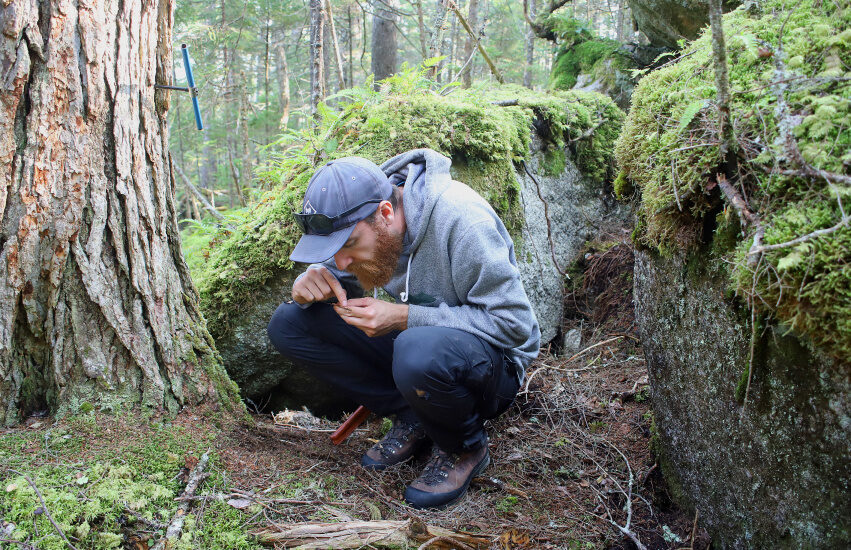KJIPUKTUK (Halifax) – Half hour west of Halifax, spanning 32,000 acres between the Panuke and Indian lakes immediately north of Highway 103, there waits a wilderness, simmering with potential and public use, aspiring to protection from our provincial government, all the while being slowly disassembled by people with chainsaws.
What we now call the proposed Ingram River Wilderness Area was first conceptualized by the St Margaret’s Bay Stewardship Association, a charity established in 2003 to, among other things, protect this watershed feeding the St Margaret’s Bay. Originally, there wasn’t much they could do, since these acres were owned by the now defunct Bowater Mersey Paper Company and subject to routine and private harvests, but when Bowater closed in 2012, the association called on the province to purchase this abused wilderness as part of the Buy Back the Mersey movement. And it worked.
All 32,000 acres were transmogrified from private to public land, and the St Margaret’s Bay Stewardship Association proposed it become a community forest – a fundamentally more sustainable management model which would be administered by a cooperative on behalf of the community at large, but their proposal was rejected in 2013 by the provincial government.
That same year, a 170 acre clearcut, sanctioned by the province, tore through the Ingram River Wilderness just south of Panuke Lake, which came as a shock to the association as this ran contrary to the goals of Buy Back the Mersey. It was followed by several others, including a 900 acres cut in 2016. Nova Scotia had clearly decided this landscape was open for business.
So, the association changed its approach, abandoning their ambitions for a community forest and suggesting instead a provincial park. There was precedent, after all. Big St Margaret’s Bay Provincial Park and Island Lake Provincial Park, both of which would have incorporated portions of the Ingram River Wilderness, had been actively considered by the province as recently as 2007. Neither materialized, obviously, but maybe the idea could be restored and expanded.
This approach too was rejected. Any hypothetical Ingram River Provincial Park would require costs the province wasn’t eager to shoulder, so the proposal changed once more, into the Ingram River Wilderness Area, a designation which would preclude forestry, require no active management, keep the landscape open for public use, and be quite cheap.
That’s how it’s been since 2016, the St Margaret’s Bay Stewardship Association cataloguing the various ecological and recreational virtues of the proposed Ingram River Wilderness Area in order to strengthen their case, while clearcutting continued with provincial approval. In the words of Mike Lancaster, the association’s stewardship coordinator, “It does feel like we’re playing whack-a-mole with these harvests that keep coming up. We’re trying to plug holes in a boat made out of paper.”
See also: News brief: Wilderness designation of unique ecological area near Halifax reaches critical stage
He estimates 80 per cent of the proposed Ingram River Wilderness Area has been cut in the last 60 years, meaning much of the landscape is still in active recovery, but the remaining 20 per cent, the fragments of intact and mature forest slowly spreading to cover the wounds, are spectacular.

Mike himself has identified over 130 forest stands in the Ingram whose trees exceed 125 years old. Many of these exceed 200 years, and a handful exceed 300. Only three trees in all 32,000 acres have broken the 400 year threshold, rarified air for any tree in the Maritimes. The oldest of these was discovered only last year, in the late afternoon of September 27th, on one of the ancient islands of Island Lake, a popular paddling destination. The uncertainties associated with tree coring prevented an accurate count, but Mike, who cored the tree himself, placed its age between 430-450 years, making it one of the oldest trees in the province.
And there’s more. The proposed Ingram River Wilderness Area supports provincially rare Red spruce dominant stands, contains some of the largest continuous and unprotected old growth forests in Nova Scotia, shelters one of the province’s narrowest wildlife corridors and harbours innumerable species-at-risk, not least of which the mainland moose.
The St Margaret’s Bay Stewardship Association requested a “wilderness assessment” from the relevant government departments, which would have been the first step in a series of steps to establish a proper wilderness area, and would, in a way, force a yes-or-no answer from the province. Instead they were granted a “biodiversity assessment,” a mechanism the province apparently invented on the spot, wherein government staff and members of the association collaborate on a study of the area’s biodiversity value. This is the first and last time a “biodiversity assessment” has been conducted in Nova Scotia, to Mike’s knowledge. It has no precedent and no next steps. But, it came with a logging moratorium which holds to this day, so the association accepted.
The biodiversity assessment began in January, 2019, and was followed by public consultation on the proposal itself in the fall of 2020. No results have yet been made public. And in the meantime, the promised moratorium has been…imperfect. “One of most significant old growth Red Spruce stands,” Mike has ever seen was destroyed during road construction in late 2019, which, according to the province, didn’t count. Association staff also discovered many acres of exceptional old growth east of Panuke Lake and added them to their proposal, but the province declined to include them under the moratorium, and have since proposed they be cut. Twelve parcels await the axe, 510.62 acres total, among them an Eastern hemlock 402 years old. Mike referred to these acres as, “perhaps the most ecologically significant region of the proposed [Ingram River Wilderness Area.]”
That brings us to the present day, another spectacular example of what it takes to keep forests standing in stark contrast to the orderly process of tearing them down.
But things have changed since 2003, in those early days of scrappy conservation in the watershed of St Margaret’s Bay. The various values of the Ingram River Wilderness have been demonstrated to the satisfaction of over fifty Nova Scotian organizations and businesses now formally lending their support for the protection of these 32,000 acres. Among them are the Confederacy of Mainland Mik’maq, Tourism Industry Association of Nova Scotia, and Arch Diocese of Nova Scotia and PEI of the Anglican Church, as well as the usual suspects, like the Canadian Parks and Wilderness Society and Nature Nova Scotia.
Ongoing harvests, upcoming elections and the chronic undervaluing of intact ecosystems have forged a sense of urgency along the Ingram River, but this has bred momentum which might force a decision in the coming months, demonstrating either the virtue of perseverance and public engagement, or the stifling headwind of unconscious economics. When asked about progress via email in late May, the Department of Lands and Forestry said they are, “reviewing the results of [the biodiversity assessment] and [public] consultation, and will announce any decisions that impact this region in the near future.”
As our leaders opine about percentages of protected land and the integrity of regional biodiversity, as they did later in this email, progress might yet be found in the Ingram.
Zack Metcalfe is a freelance journalist, columnist and author active across the Maritime.
See also: Weekend video: An interview with Ralph Wheadon, long time Provincial Forest Ranger
Check out our new community calendar!
With a special thanks to our generous donors who make publication of the Nova Scotia Advocate possible.
Subscribe to the Nova Scotia Advocate weekly digest and never miss an article again. It’s free!




Many of the proponents are in Rankin’s riding or close-by and have supported him; he knows this file well. It is also land that now retired Jon Porter, (ex Bowater Man) wanted to keep in the Big Forestry domain. So the choices for Rankin are pretty clear, if uncomfortable.
Brilliant article Zach. Great job! IRWA is clearly a concept whose time has come.
Thanks for the update and history of this area👍